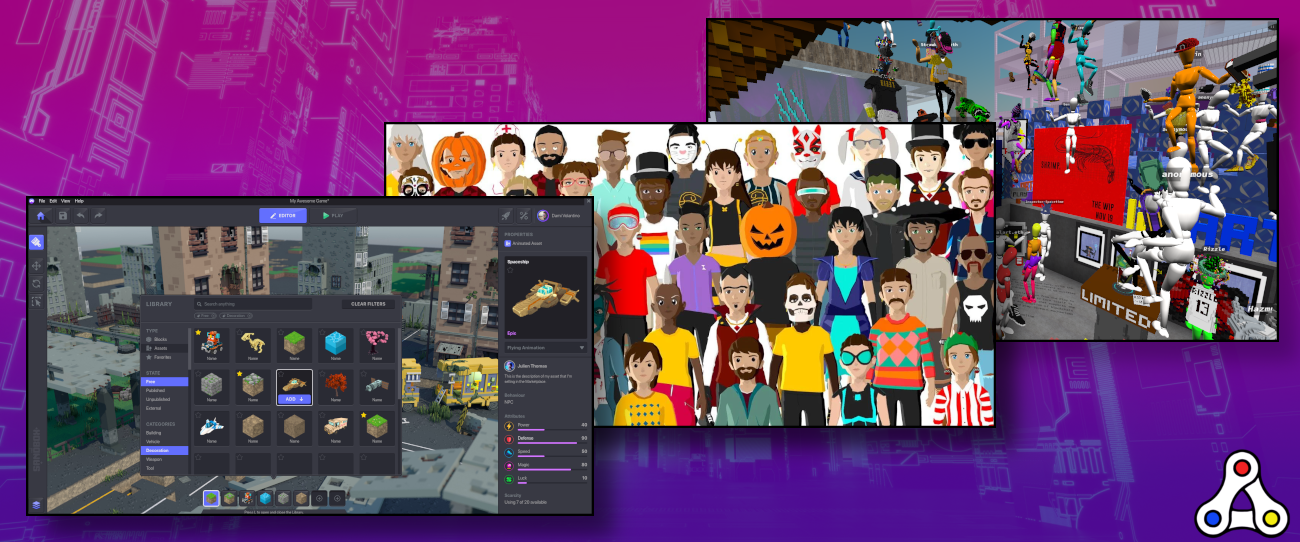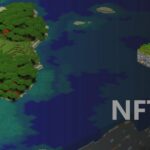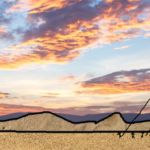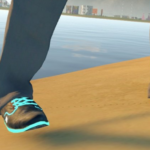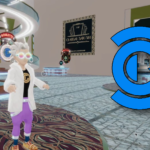Virtual worlds gain popularity amidst the growing interest in non-fungible tokens, but what’s really needed for them to become a success? In this article I take a look at features that virtual worlds need to embrace to become mainstream powerhouses. The ultimate goal is easy access to content and full interoperability across the metaverse.
Before we start. Credits to Andrew Steinwold for providing the inspiration for this article. He posted a thread with his ideas about interoperability and virtual worlds, and I transformed that into the ten key ingredients for virtual worlds to have success.
Dawn of the metaverse
We are at the dawn of a new age in which the metaverse is slowly becoming a concept that’s all around us. Virtual worlds and blockchain technology spawn new relationships between businesses and consumers as everybody is a participant in the virtual economy. But what do virtual worlds need to become a success?
Classically speaking there’s a clear differentiation between virtual reality and our physical world. We need to put on a VR headset and then we get to experience something that’s more like a world away from our own reality. It’s an escape. This escape tells its own stories, has its own economy, but aside from the experiences from the player or user, hardly anything merges with the physical world.
That’s why blockchain-powered virtual worlds are so interesting. Suddenly users can acquire a non-fungible token, which serves as an ownership contract over a piece of virtual land. On this virtual land they can create anything they like, even use this land as a virtual expansion of their real life business. The moment a user becomes an owner, everything changes. Everything.
Keep in mind, these are my personal thoughts. In this article I’m not looking at the on-boarding process. It’s a no-brainer that the user experience should be as smooth as possible for people to get into crypto and blockchain technology. As a matter of fact, probably users shouldn’t even know that they are working with blockchain technology. All that matters is true user ownership. Now, let’s assume users have their first crypto and now want to get into virtual worlds… what do these virtual worlds need to provide?
1 – Easy Content Building
When you have one million users, you can’t expect everybody to have the technical knowhow. In order for virtual worlds to become a success, it should be super easy to create and build something. Building in Minecraft and Roblox is very easy because of their LEGO-inspired crafting system. That’s why voxels make so much sense. However, virtual worlds embracing 3D designs – like Somnium Space and Decentraland – should embrace snapping, to easy connect building pieces together at the edges. A more complex and precise version of such an editor could be useful for more experienced builders. It’s crucial to offer easy ways to create content, because a virtual world definitely needs content.
2 – Easy Content Acquisition
There will be people who build a gigantic museum from scratch, but there will also be people that are not skillful enough to create great content. Therefore there should be an option to acquire, buy, license, or borrow assets. Think about virtual furniture, but also about bigger elements like a readymade bedroom or even an entire house.
3 – Create a social space
Ultimately virtual worlds need to be a social space to become a success. The virtual citizens of the metaverse need to be able to be social. Voice chat, text chat, and the use of emojis are just the start. Think bigger, and allow people to leave letters in a mailbox for a specific person (e-mail) and allow them to decorate designated walls with messages (graffiti). Each of the players will have NFTs in their wallet. Allowing users to literally give an NFT inside the world to another user, would be a huge move. It would enable in-world gifting. Imagine celebrating your birthday in the metaverse?
4 – Avatar Personalization
The success of virtual worlds is also driven by the ability for users to express themselves visually. Even though we’re now talking about surpassing our physical form, humans are still social creatures. We like to express ourselves through our creations and out clothing. Therefore digital avatar should have the option to be personalized. Just like building a house, creating or buying virtual clothing should be easy. These non-fungible tokens could be gifted, they can come in different rarities and obviously these clothes don’t need to be restricted by the physical limitations of clothing. Wearing a dragon skin with its fire spitting head on top of your own virtual head, should be fine.
5 – Social Multiplayer
When you have a dressed-up avatar and some friends inside the virtual world, you will also need something to do. A successful virtual world isn’t a static canvas, but there needs to be interactivity. The social layer needs to move beyond chat and allow for friendly forms of competition and interaction. Simple game elements are of utmost importance. Gaming is what creates friendships. Think about your childhood, during which dodgeball, hide & seek and playing tag were the most popular games.
Another good example would be arcade games, where friends gather to be competitive in a friendly way. These virtual worlds need to provide a sense of gamification. It would be even better if there’s a overall sense of progress, perhaps through experience points, but collecting a proof-of-attendance when you visit an event, set a high score or win a competition is also an interesting way to add a sense of progress to a virtual world. Just look at the success of GTA Online and Fortnite. It’s not only about winning, but also about adding social layers to the competitions.
6 – Land supply
Ultimately 1 million people should be able to buy land and build their own virtual home or business. Nobody benefits from the fact that 50 people with deep pockets acquire all the land on the market and resell this at a premium. That’s not a way to be inclusive to new people from different backgrounds. The virtual world should be liberating, and should therefore not hold the American or European price for land value as a standard. How do you make sure someone from Indonesia also has the opportunity to join without KYC limitations in place?
I guess some form of background check is required, perhaps on a wallet level. Another option would be a proof-of-participation (just made that up). Perhaps users who want to buy land for ‘cheap’ first need to contribute to the virtual world in another way. For example by creating assets with a Creative Commons License, which in turn can be used freely by everybody. Anyway, there should be a clear communication about the total land supply and its emission of the course of time, because that type of certainty provides a strong message. Success in virtual worlds only makes sense when many different layers of society have a chance to participate.
7 – The World as a Playground
A virtual world shouldn’t be just one thing. It just seems wrong to have an entire virtual world filled with art galleries. In the same way it also feels wrong to have a world filled with games-only. Just look at a big city, where there are shopping centers, sports complexes, museums, theatres, music venues, stadiums and so on. In Decentraland we’ve seen a team-based football competition, in Cryptovoxels there have been plenty of art shows, and recently there was a music performance in Somnium Space.
A virtual world should provide all of these: shops, gaming, art galleries, live performances and more. From a technical point of view this should mean that a virtual world allows the integrations of APIs. Think about WooCommerce and Shopify integration for shops, the ability to show and buy digital art directly in-world, and of course the option to integrate games in a virtual world. When I’m playing a pinball game inside a virtual world, I might get hungry. In that case I want the option to buy a pizza and have it delivered to my actual house.
8 – Neighborhoods
Historically neighborhoods form by themselves. In more modern cities the government decides to create a shopping mall or build a new football stadium with a sports complex around it. In virtual worlds there needs to be a stimulations for neighborhoods to pop-up. Having a district dedicated to art is great, the same for shopping or live performances. The virtual world should provide easy ways to travel between those districts. Think about teleportation portals. However, there shouldn’t be any neighborhood restrictions. If someone wants to build an art gallery in the shopping area, than that should be allowed. Neighborhood names and descriptions can change over time, and ultimately the citizens decide on what happens in a neighborhood. As a government or virtual world creator you can only provide guidance and the tools necessary to create.
9 – Combat Empty Lands
When virtual worlds are filled with content, it’s more likely to be a success. However, not everybody landowner will be building. At the moment traveling through a virtual world can be an interesting challenge. Right now lots of virtual land is still empty. Empty lands don’t provide a nice incentive for visitors to return, and thus we need to provide tools to highlight activity. With the press of a button users could get a pop-up that highlights current popular locations. Something similar should be possible for current and upcoming events. This would generate purpose, while increasing retention and engagement. Another great idea is to allow people to easily share points of interest. Being a virtual tour guide could become a job of the future.
Recently the Cryptovoxels had an interesting proposal to allow neighbors to build on empty plots next door in order to add color to the neighborhood. These dormant plots can be created into shared spaces until the owner shows up and starts building themselves. It’s actually quite a similar practice with real-world real-state, where pop-up stores fill the empty spaces in shopping areas, and where old factories become hubs for creative designers. Empty land gets a new purpose for the common good, until the owner does something new with it.
10 – Interoperability
A virtual world on the blockchain will be a lot like Minecraft or Roblox, unless it adds features for interoperability. Only when assets and identities move freely across different virtual worlds, the concept of the metaverse will live up to its true potential. Of course land ownership is an amazing feature, but interoperability is the true key to success of the metaverse.
This means interoperability between different virtual worlds, between gaming and apps, but also between real-world services and virtual worlds. A trophy won in a football competition in Decentraland, should allow to be shown inside Cryptovoxels. A concert ticket bought at TicketMaster for a Beyoncé Show, should also give you access to a virtual venue inside a virtual world. The purchase of an artwork from SuperRare should give you access to an exclusive section of their virtual museum. The race car you own in F1 Delta Time should also be your number one transportation inside Somnium Space. Your avatar in any virtual world should have the option the be identical in other virtual words, creating one virtual identity to use across different worlds: a passport for the metaverse.

